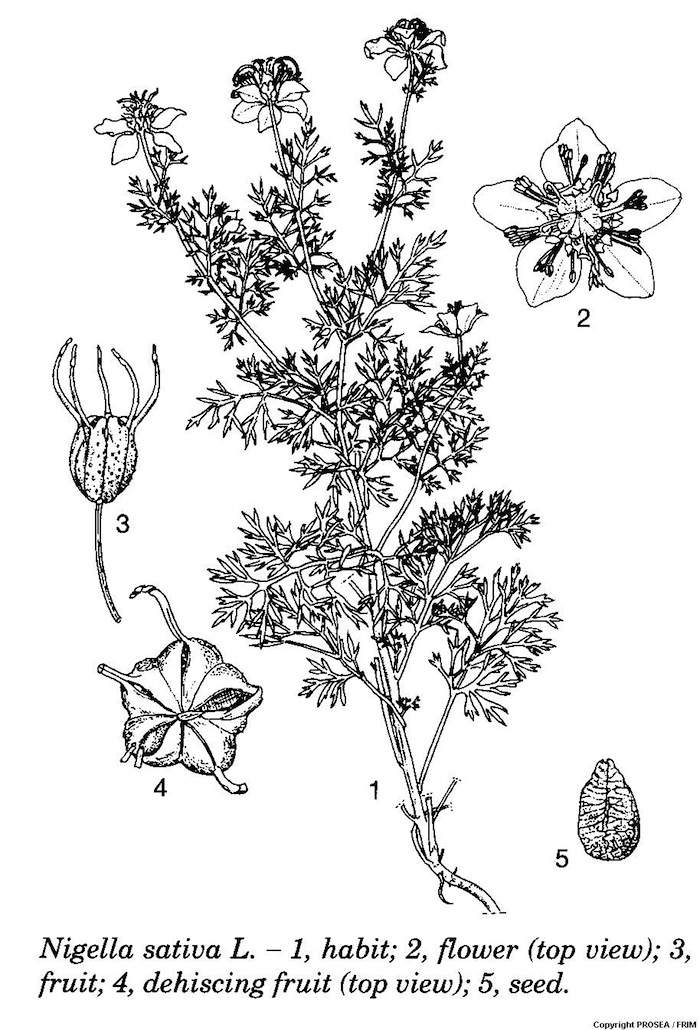Nigella sativa L.
Family
Ranunculaceae
Synonyms
Nigella cretica Miller, Nigella indica Roxb. ex Fleming.
Vernacular Names
|
Malaysia |
Jintan hitam. |
|
English |
Black cumin, small fennel, love-in-a-mist. |
|
Indonesia |
Jinten hitam. |
|
French |
Cumin noir, nigelle cultivée, toute-épice. |
Geographical Distributions
Nigella sativa is probably indigenous to the Mediterranean region and the Middle East up to India. It has long been cultivated and is mentioned in ancient Hebrew, Greek and Roman texts. It is cultivated in the subtropical belt extending from Morocco to northern India and Bangladesh, in East Africa and in the former Soviet Union. In Europe, North America and Southeast Asia, it is cultivated on a minor scale mainly for medicinal purposes.
Description
Nigella sativa is an erect annual herb, up to 70 cm tall, with a well-developed yellow-brown taproot and numerous feeder roots. The stem is profusely branched, subterete, ribbed, and sometimes hollow when old and light to dark green.
The leaves are arranged alternately. The stipules are absent. The petiole is strongly broadened at the base, light green, only present in basal leaves, measures 1-6 cm long, ribbed and minutely hairy. The leaf measures up to 7 cm x 5 cm in outline, bi-,tri- or even multi-pinnately dissected into short, thin sublinear, divergent, slightly pilose lobes, which are normally green but sometimes turn reddish brown.
The flowers are terminal and solitary. The pedicel is (2-)4-8(-11) mm long, minutely hairy and ribbed. All parts of the flower are inserted on a pale yellow, fleshy, depressed-conical receptacle, measuring about 2 mm in diametre and visible as an orange-brown ring below the carpels in fruit. There are 5 sepals which are petal-like, ovate, measuring 13-17 mm x 6-12 mm, obtuse at apex, basally tapering into a claw 2-3 mm long and papillose to pilose. The sepal is pale green when young but sometimes partly reddish while the inside is pale blue-white when becoming older. There are (6-)8(-11) petals which are with short claw, 2-lobed blade, with lobes enclosing the nectar pocket, with dorsal lobe measuring 3.5-5.5 mm x 2.5-4.5 mm, with bifid apex, greenish-white with violet lines, with oblong ventral lobe, measuring 2.5-4 mm long, violet at the base and white at the apex. The stamens are in (6-)8(-10) groups with 3-7 stamens each. The filaments are 3-9 mm long, linear, violet-blue to pale blue and with yellow anthers. The pistil is lobed and composed of 3-7 white-granular carpels. It is almost connate at the base and forms a compound ovary, which is 4-9 mm long with free stigmas.
The fruit is a ribbed, oblongoid, tuberculate capsule, measuring 6-16 mm x 5-12 mm, greyish-green to brown at maturity, many-seeded and with persistent stigmas.
The seed is 3(-4)-sided, obpyramidal measuring 3 mm x 1.5-2 mm, wrinkled-tuberculate, dark black and with a carrot-like smell. Its embryo is minute, embedded in copious and fatty endosperm.
Ecology / Cultivation
Nigella sativa is a hardy crop and can grow under a wide range of temperatures from 5-25°C, the optimum being about 14°C. In Ethiopia, it is cultivated as a rainfed crop in the highlands at 1500-2500 m altitude. It is successfully grown in most kinds of soil with pH 5-8.
Line Drawing / Photograph
Read More
1) Safety
References
-
Plant Resources of South-East Asia No.13: Spices.




